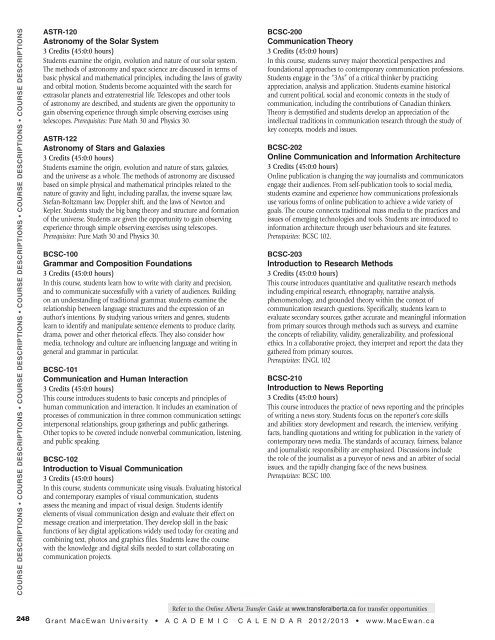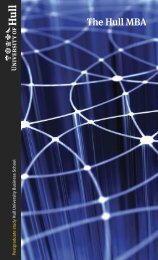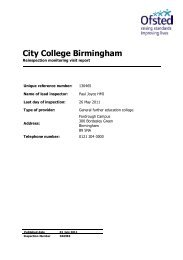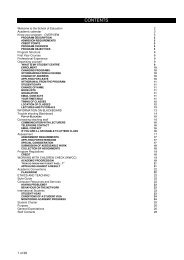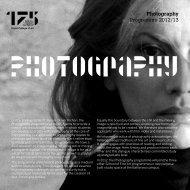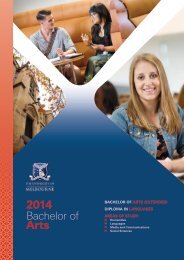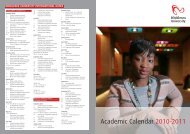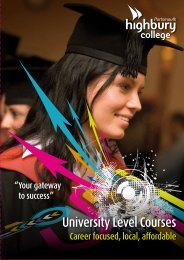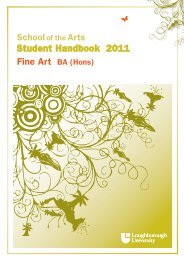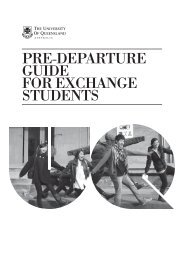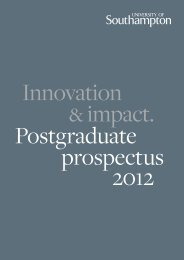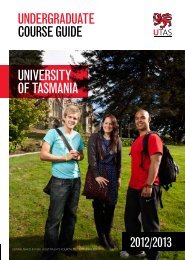Academic Calendar 2012/2013
Academic Calendar 2012/2013
Academic Calendar 2012/2013
Create successful ePaper yourself
Turn your PDF publications into a flip-book with our unique Google optimized e-Paper software.
course Descriptions • course Descriptions • course Descriptions • course Descriptions • course Descriptions • course DescriptionsASTR-120Astronomy of the Solar System3 Credits (45:0:0 hours)Students examine the origin, evolution and nature of our solar system.The methods of astronomy and space science are discussed in terms ofbasic physical and mathematical principles, including the laws of gravityand orbital motion. Students become acquainted with the search forextrasolar planets and extraterrestrial life. Telescopes and other toolsof astronomy are described, and students are given the opportunity togain observing experience through simple observing exercises usingtelescopes. Prerequisites: Pure Math 30 and Physics 30.ASTR-122Astronomy of Stars and Galaxies3 Credits (45:0:0 hours)Students examine the origin, evolution and nature of stars, galaxies,and the universe as a whole. The methods of astronomy are discussedbased on simple physical and mathematical principles related to thenature of gravity and light, including parallax, the inverse square law,Stefan-Boltzmann law, Doppler shift, and the laws of Newton andKepler. Students study the big bang theory and structure and formationof the universe. Students are given the opportunity to gain observingexperience through simple observing exercises using telescopes.Prerequisites: Pure Math 30 and Physics 30.BCSC-100Grammar and Composition Foundations3 Credits (45:0:0 hours)In this course, students learn how to write with clarity and precision,and to communicate successfully with a variety of audiences. Buildingon an understanding of traditional grammar, students examine therelationship between language structures and the expression of anauthor’s intentions. By studying various writers and genres, studentslearn to identify and manipulate sentence elements to produce clarity,drama, power and other rhetorical effects. They also consider howmedia, technology and culture are influencing language and writing ingeneral and grammar in particular.BCSC-101Communication and Human Interaction3 Credits (45:0:0 hours)This course introduces students to basic concepts and principles ofhuman communication and interaction. It includes an examination ofprocesses of communication in three common communication settings:interpersonal relationships, group gatherings and public gatherings.Other topics to be covered include nonverbal communication, listening,and public speaking.BCSC-102Introduction to Visual Communication3 Credits (45:0:0 hours)In this course, students communicate using visuals. Evaluating historicaland contemporary examples of visual communication, studentsassess the meaning and impact of visual design. Students identifyelements of visual communication design and evaluate their effect onmessage creation and interpretation. They develop skill in the basicfunctions of key digital applications widely used today for creating andcombining text, photos and graphics files. Students leave the coursewith the knowledge and digital skills needed to start collaborating oncommunication projects.BCSC-200Communication Theory3 Credits (45:0:0 hours)In this course, students survey major theoretical perspectives andfoundational approaches to contemporary communication professions.Students engage in the “3As” of a critical thinker by practicingappreciation, analysis and application. Students examine historicaland current political, social and economic contexts in the study ofcommunication, including the contributions of Canadian thinkers.Theory is demystified and students develop an appreciation of theintellectual traditions in communication research through the study ofkey concepts, models and issues.BCSC-202Online Communication and Information Architecture3 Credits (45:0:0 hours)Online publication is changing the way journalists and communicatorsengage their audiences. From self-publication tools to social media,students examine and experience how communications professionalsuse various forms of online publication to achieve a wide variety ofgoals. The course connects traditional mass media to the practices andissues of emerging technologies and tools. Students are introduced toinformation architecture through user behaviours and site features.Prerequisites: BCSC 102.BCSC-203Introduction to Research Methods3 Credits (45:0:0 hours)This course introduces quantitative and qualitative research methodsincluding empirical research, ethnography, narrative analysis,phenomenology, and grounded theory within the context ofcommunication research questions. Specifically, students learn toevaluate secondary sources, gather accurate and meaningful informationfrom primary sources through methods such as surveys, and examinethe concepts of reliability, validity, generalizability, and professionalethics. In a collaborative project, they interpret and report the data theygathered from primary sources.Prerequisites: ENGL 102BCSC-210Introduction to News Reporting3 Credits (45:0:0 hours)This course introduces the practice of news reporting and the principlesof writing a news story. Students focus on the reporter’s core skillsand abilities: story development and research, the interview, verifyingfacts, handling quotations and writing for publication in the variety ofcontemporary news media. The standards of accuracy, fairness, balanceand journalistic responsibility are emphasized. Discussions includethe role of the journalist as a purveyor of news and an arbiter of socialissues, and the rapidly changing face of the news business.Prerequisites: BCSC 100.248Grant MacEwan University • A C A D E m I CRefer to the Online Alberta Transfer Guide at www.transferalberta.ca for transfer opportunitiesC A L E N D A R <strong>2012</strong>/<strong>2013</strong> • www.MacEwan.ca


